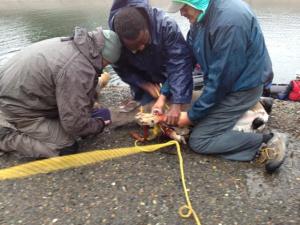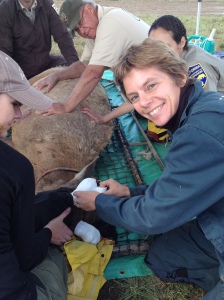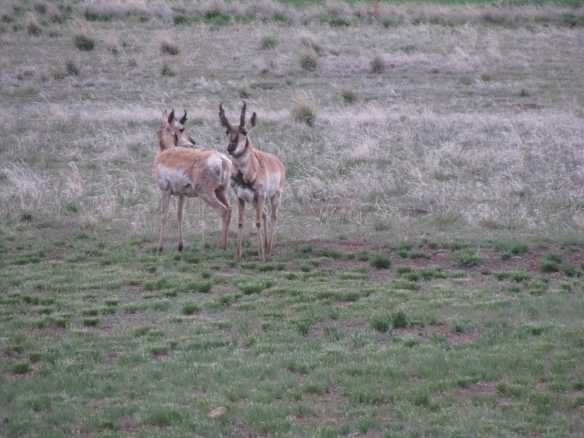By Tom Batter, WIL Scientific Aid
California has been experiencing persistent dry conditions since 2012. According to the National Drought Mitigation Center at the University of Nebraska-Lincoln, 99% of California is currently abnormally dry, 67% of California is in extreme drought, and almost 10% is experiencing exceptional drought — and it may not let up soon. The implication of a drought emergency is relatively straightforward: there is a severe lack of water. This lack of water affects Californians in many ways, be it economically or socially. But how does it affect the state’s wildlife?

Nearly 99% of California is “abnormally dry”, 67% of the state is experiencing “extreme drought”, and 10% is experiencing “exceptional drought” (as of February 4, 2014). Photo courtesy of the U.S. Drought Monitor. Click here for the most up to date drought conditions in California.
California’s wildlife depends on water just as it’s citizens do. With water resources becoming increasingly rare, a “domino effect” takes place in the ecosystem. Drought conditions negatively impact habitat through resource deterioration and wildfire, causing migration and behavior changes of animals. Wildlife become concentrated in remaining suitable habitat, increasing chances for disease outbreaks due to close contact.
It begins at the producer level. As drought intensity increases, vegetation growth is stymied. Plants that lack necessary water resources respond by reducing new stem growth while previously produced stems will shrivel and die. The obvious effect from lowered plant production is a reduction in food availability for herbivores. This in turn reduces populations of insects, reptiles, wild rodents, and hares which many small carnivores and raptors rely upon for food.
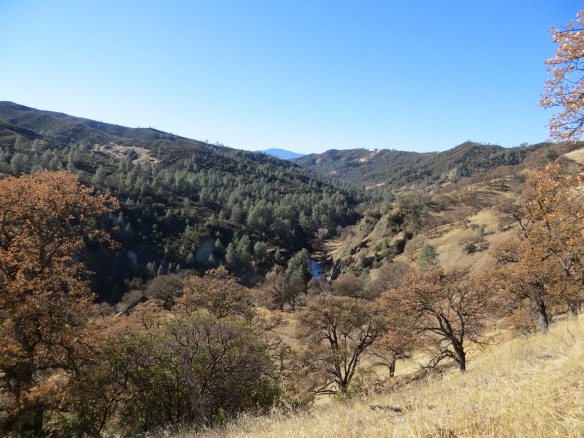
Dry conditions at Cache Creek, Lake County, in late December 2013. Photo credit: Krysta Rogers, Wildlife Investigations Lab (WIL).
With lower food availability, animals tap into their body’s fat reserves. Utilizing fat reserves will ultimately lead to starvation for wildlife whose nutritional needs are not eventually fulfilled. Beginning in mid-December, WIL began documenting increased mortality of young red-tailed hawks in central and southern California. Investigation revealed poor body condition, emaciation, and secondary bacterial or fungal infections. A similar event occurred the previous winter, also in dry conditions.

Drought impacts all trophic levels, including birds of prey such as the red-tailed hawk (pictured). Photo credit: U.S. Fish & Wildlife Service (USFWS).
Reduced plant growth also negatively affects available cover for wildlife. Cover is an important element for prey species to evade predators. As plant life diminishes, landscapes become more open. For some wildlife, such as ground nesting birds, the likelihood of predation increases as these drought ridden landscapes open up.
With the odds already stacked against them, wildlife in drought conditions are also forced to travel greater distances in search of food and water resources. Some behavior changes may take place as a result; for example, typically nocturnal species such as raccoons and opossums may remain active well into the daylight hours seeking food. The extra effort for nutrients puts these animals at an increased risk of exhaustion, starvation, predation, and disease.
As drought conditions persist, animals will seek out alternative habitats that have more favorable conditions for survival. Areas where food and water are still available will attract many species to a relatively small area. Predation rates are likely to increase as predators can more easily focus on a centralized group of prey. Furthermore, large concentrations of wild animals increase the odds for disease outbreaks that could decrease populations.
In fact, this winter WIL has already investigated several avian cholera outbreaks throughout California. Large numbers of ducks, geese, and swans spend the winter on the state’s many ponds and lakes. The current lack of precipitation has reduced the amount of habitat available for these birds, forcing them to become concentrated in locations where water remains. Close contact among waterfowl allows a bacterial disease like avian cholera to spread very rapidly, resulting in the death of hundreds to thousands of birds.

A variety of waterfowl species congregate at the Sacramento National Wildlife Refuge. Photo credit: Scott Flaherty, USFWS Pacific Southwest Region.
While these impacts of drought do indeed create dire circumstances for wildlife, it is important to remember that droughts are natural phenomena. Wildlife and drought have coexisted for generations upon generations. Generally speaking, wildlife populations are resilient and are able to bounce back from drought events once typical weather patterns return. For example, in the early 1960s severe winter drought contributed to extreme deer die-offs in Texas. When rainfall levels returned to normal, the deer population was able to rebound in only one year.
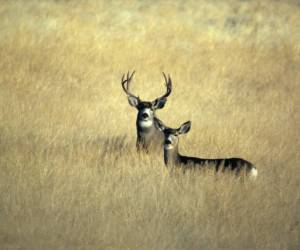
Many species of wildlife, such as mule deer, are capable of bouncing back after drought once conditions return to normal. Photo credit: T.A. Blake, USFWS
During these hard times, it may be tempting to “rescue” or “save” an animal that is seeking food and water. It is entirely possible that more wildlife will make their way into urban and residential areas in an attempt to find nutrients. It would be a disservice to both human and animal to offer handouts, for similar reasons it is inappropriate to keep wildlife as pets. This natural drought event will eventually pass, and when it does, CDFW and WIL staff would rather see California’s fauna remain reliant upon themselves rather than their human counterparts.
